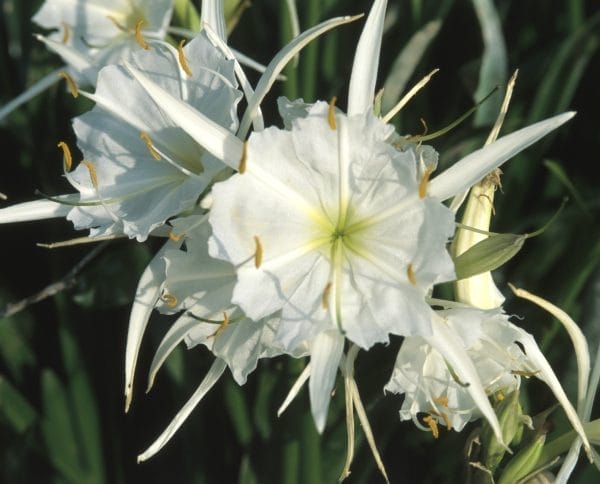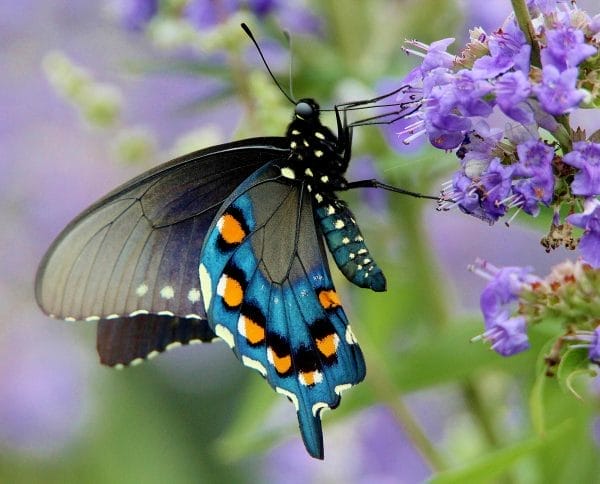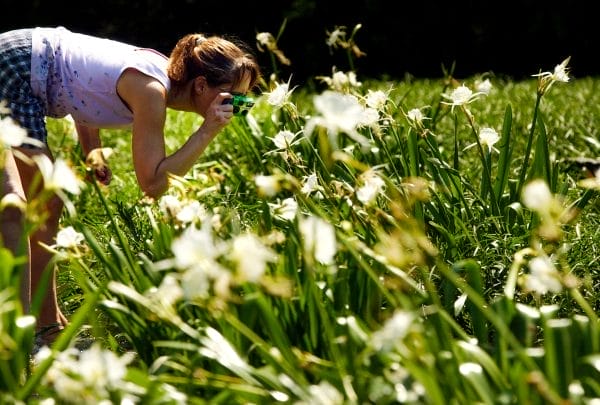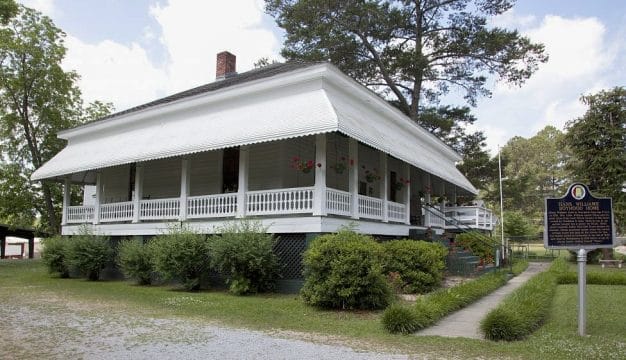Cahaba Lily
 Cahaba Lilies
The Cahaba lily (Hymenocallis coronaria) is an aquatic flowering plant native to the major river systems of Alabama, Georgia, and South Carolina. A type of spiderlily belonging to the amaryllis family, the Cahaba lily is noted for the striking beauty of its three-inch-wide white flowers. The lily requires a very specialized habitat—swift-flowing water over rocks and lots of sun—and thus is restricted to shoal areas at or above the fall line. In Alabama, the Cahaba lily is restricted to the Black Warrior, Cahaba, Coosa, Tallapoosa, and Chattahoochee river systems. Plant bulbs and seeds spend the winter buried in the rocky riverbed. There the water’s current securely wedges the seeds and bulbs into the rock crevices. Leaves begin to emerge above the water line in mid-April, following the spring floods (dates are approximately two weeks later in eastern Georgia and South Carolina). Flower stalks develop after the leaves are fully emerged, with each stalk capped by six to nine buds surrounded by protective casings called bracts. Flowering commences in mid-May, reaching its peak in late May and early June, with sporadic flowering until late June.
Cahaba Lilies
The Cahaba lily (Hymenocallis coronaria) is an aquatic flowering plant native to the major river systems of Alabama, Georgia, and South Carolina. A type of spiderlily belonging to the amaryllis family, the Cahaba lily is noted for the striking beauty of its three-inch-wide white flowers. The lily requires a very specialized habitat—swift-flowing water over rocks and lots of sun—and thus is restricted to shoal areas at or above the fall line. In Alabama, the Cahaba lily is restricted to the Black Warrior, Cahaba, Coosa, Tallapoosa, and Chattahoochee river systems. Plant bulbs and seeds spend the winter buried in the rocky riverbed. There the water’s current securely wedges the seeds and bulbs into the rock crevices. Leaves begin to emerge above the water line in mid-April, following the spring floods (dates are approximately two weeks later in eastern Georgia and South Carolina). Flower stalks develop after the leaves are fully emerged, with each stalk capped by six to nine buds surrounded by protective casings called bracts. Flowering commences in mid-May, reaching its peak in late May and early June, with sporadic flowering until late June.
 Pipevine Swallowtail
Flowers open in the early evening at a time when they are most fragrant and full of nectar. The six petals surround a membranous corona, which connects the lower portions of the stamens. The lily’s scientific name, translated as “beautiful crown-like membrane,” accurately depicts these characteristics. The development of the individual flower buds on a stalk takes place in a set sequence, and a fresh flower opens each day for pollinators. Both nocturnal and diurnal pollinators have been observed visiting the flowers, notably the plebeian sphinx moth (Paratrea plebeja) and the pipevine swallowtail (Battus philenor). Following fertilization, the ovaries gradually expand until they split, and the oblong, olive-sized green seeds complete their development outside the ovary wall. The heavy seeds bend the flower stalk down into the water, and the mature seeds drop to the stream bottom and are swept into rock crevices by the current. Germination follows in about a week, resulting in small bulbs with strap-like leaves.
Pipevine Swallowtail
Flowers open in the early evening at a time when they are most fragrant and full of nectar. The six petals surround a membranous corona, which connects the lower portions of the stamens. The lily’s scientific name, translated as “beautiful crown-like membrane,” accurately depicts these characteristics. The development of the individual flower buds on a stalk takes place in a set sequence, and a fresh flower opens each day for pollinators. Both nocturnal and diurnal pollinators have been observed visiting the flowers, notably the plebeian sphinx moth (Paratrea plebeja) and the pipevine swallowtail (Battus philenor). Following fertilization, the ovaries gradually expand until they split, and the oblong, olive-sized green seeds complete their development outside the ovary wall. The heavy seeds bend the flower stalk down into the water, and the mature seeds drop to the stream bottom and are swept into rock crevices by the current. Germination follows in about a week, resulting in small bulbs with strap-like leaves.
 Cahaba Lily Festival
A number of human activities threaten the survival of the Cahaba lily, and lily populations have been completely destroyed in some areas. Historically, the major threat has come from the damming of rivers for navigation and power generation. Alabama’s largest populations of Cahaba lily, however, remain in the Cahaba River, which has no high-level dams. More recently, the lily has become threatened by increasing levels of sediment from development, logging, and mining. In addition, Cahaba lily bulbs are sometimes “poached” and sold to nurseries, a practice that has decimated smaller populations. In May 1990, the town of West Blocton, in Bibb County, established the annual Cahaba Lily Festival. Activities include presentations about the lily and other local wildflowers, the crowning of the Cahaba Lily Queen, and the opportunity to view the lilies in their best-known natural habitat, the shoals of the Cahaba River.
Cahaba Lily Festival
A number of human activities threaten the survival of the Cahaba lily, and lily populations have been completely destroyed in some areas. Historically, the major threat has come from the damming of rivers for navigation and power generation. Alabama’s largest populations of Cahaba lily, however, remain in the Cahaba River, which has no high-level dams. More recently, the lily has become threatened by increasing levels of sediment from development, logging, and mining. In addition, Cahaba lily bulbs are sometimes “poached” and sold to nurseries, a practice that has decimated smaller populations. In May 1990, the town of West Blocton, in Bibb County, established the annual Cahaba Lily Festival. Activities include presentations about the lily and other local wildflowers, the crowning of the Cahaba Lily Queen, and the opportunity to view the lilies in their best-known natural habitat, the shoals of the Cahaba River.
Further Reading
- Davenport, Lawrence J. “The Cahaba Lily.” Alabama Heritage 16 (Spring 1990): 24-29.
- ———. “The Cahaba Lily (Revisited).” Alabama Heritage 28 (Spring 1993): 48-49.
- ———. “The Cahaba Lily: Its Distribution and Status in Alabama.” Journal of the Alabama Academy of Sciences 67 (October 1996): 222–33.
- Smith, G. L., and W. S. Flory. “Treatment of Hymenocallis..” Flora of North America 26 (2002): 283-93.



